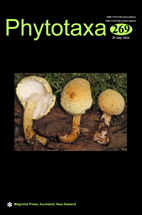Abstract
Smilax Linnaeus (1753: 1028) is the only genus of Smilacaceae, comprising ca. 210 species, which are lianas, shrubs, and herbs (Cameron & Fu, 2006; Qi et al. 2013a). The genus shows a near-cosmopolitan distribution (Qi et al. 2013a). In the large genus, Smilax sect. Heterosmilax (Kunth 1850: 270) Judd (1998: 158), formerly treated as an independent genus Heterosmilax Kunth in Smilacaceae, has 12 species and is distributed only in Asian and Malesian regions (Judd 1998, Qi et al. 2013b). All species of the section have slender stem without pricks, cordate leaves, and tendrils in bronze color. Especially, flowers with connate perigone are one of the most important characteristics to distinguish the section from the other sections (Koyama 1984, Qi et al. 2013a).

